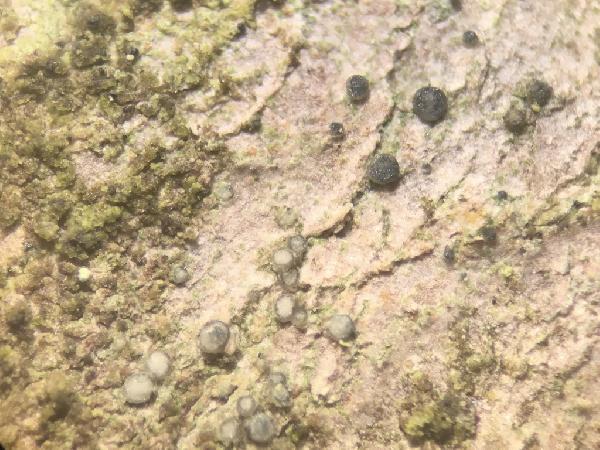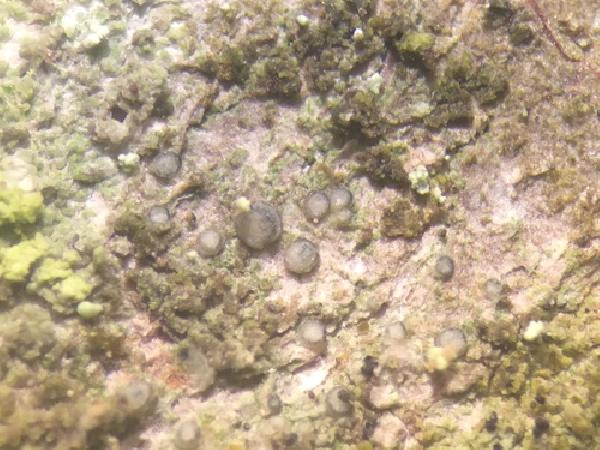Myrionora albidula (Willey) R.C. Harris
in Harris & al., Evansia, 5, 2: 27, 1988. Basionym: Biatora albidula Willey - in Tuckerman, Syn. N. Amer. Lich., 2: 130, 1888.
Synonyms:
Distribution:
Description: Thallus crustose, endo- to thinly episubstratic and then minutely granulose, whitish to pale grey, without a distinct prothallus. Apothecia biatorine, (0.1-)0.18-0.27(-0.5) mm across, at first flat and sessile, finally convex and often constricted at base, the disc whitish to dark blue-grey, often piebald with bluish speckles, occasionally entirely whitish or yellowish, the proper margin usually paler, level with disc, finally partially excluded. Proper exciple 35-60 μm wide, colourless except sometimes a blue-green pigmentation around terminal cells, composed of hyphae with heavily gelatinized walls, coherent also in K, inspersed with abundant, minute, colourless, up to 1(-2) mm long, bacilliform crystals, most of which are soluble in K and insoluble in N and acetone; epithecium colourless or with occasional blue-green pigment crystals; hymenium colourless, (35-)45-60(-65) μm high; paraphyses ± abundant, dichotomously branched in upper half, occasionally anastomosing; hypothecium colourless, of irregularly branched, thin-walled cells with up to 4 μm wide lumina. Asci (32-)50-75-spored, clavate, the outermost wall layer slightly thicker around apex, with a pointed ocular chamber, the tholus staining I+ dark blue with a paler blue, narrowly conical axial body surrounded by a I+ deep blue zone, Biatora-type. Ascospores 1-celled, hyaline, narrowly ellipsoid to short-bacilliform with rounded ends, (4.7-)6-7.6(-11.3) x (1.6-)2-2.5(-3.3) μm. Pycnidia unilocular, of two types: 1) semi-immersed to immersed, globose, 25-30 mm wide, with protruding masses of conidia producing broadly ellipsoid conidia measuring 2.5-3.5 x 1.5-2.0 μm; 2) immersed, semiglobose but slightly flattened and resembling juvenile apothecia, 40-60 mm wide, producing ellipsoid conidia measuring (3-)4(-4.5) x 1.3-1.7 mm. Photobiont chlorococcoid, the cells globose or ellipsoid, unevenly sized, (7-)12-20(-24) μm. Spot tests: thallus K-, C-, KC-, P-; apothecial ections fleeting KC+ purple. Chemistry: apothecia probably with lobaric acid.Note: a rare, but also easily overlooked species with a holarctic, northern-temperate to southern boreal distribution, growing on the bark of deciduous and coniferous trees, mostly in pristine forests; for Europe it is known from Scandinavia and Germany (Schwarzwald). For further details see Palice & al. (2013). To be looked for in the Italian Alps.
Growth form: Crustose
Substrata: bark
Photobiont: green algae other than Trentepohlia
Reproductive strategy: mainly sexual

Predictive model
Growth form: Crustose
Substrata: bark
Photobiont: green algae other than Trentepohlia
Reproductive strategy: mainly sexual

Predictive model



